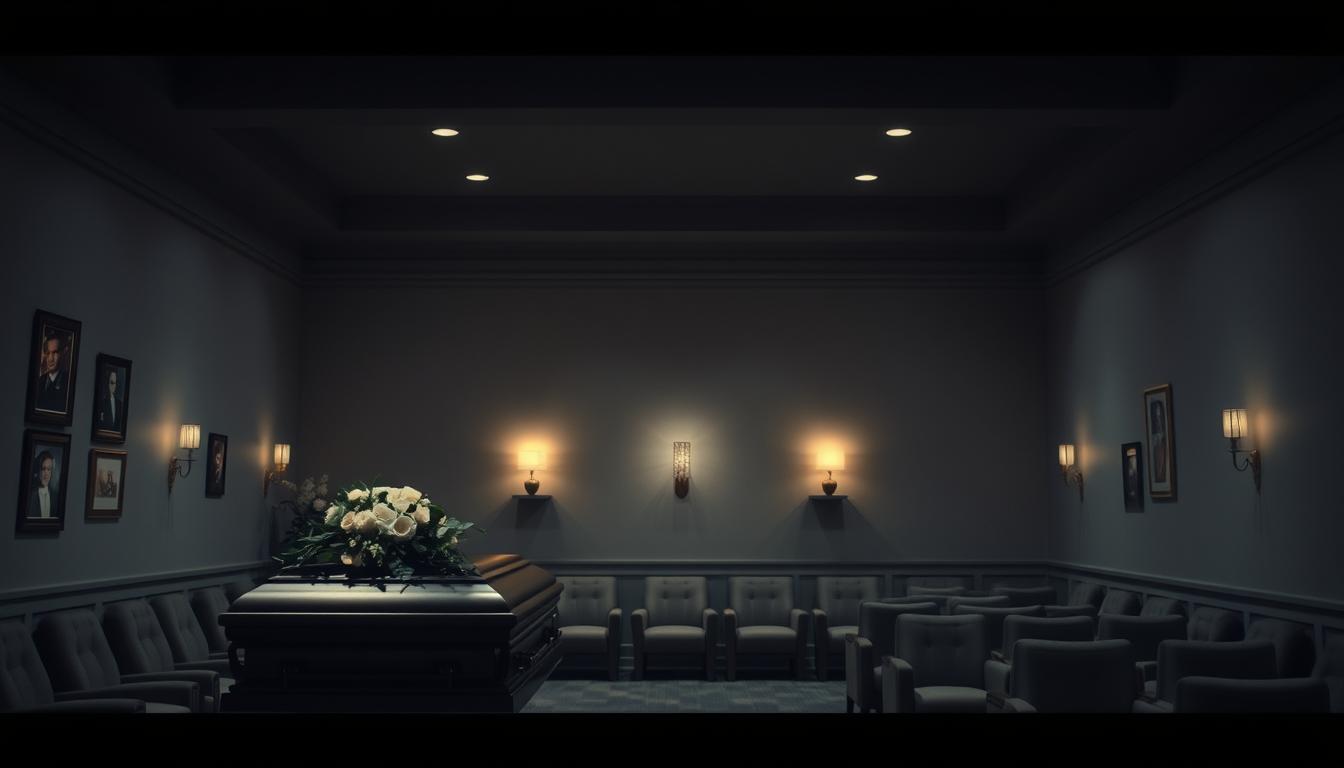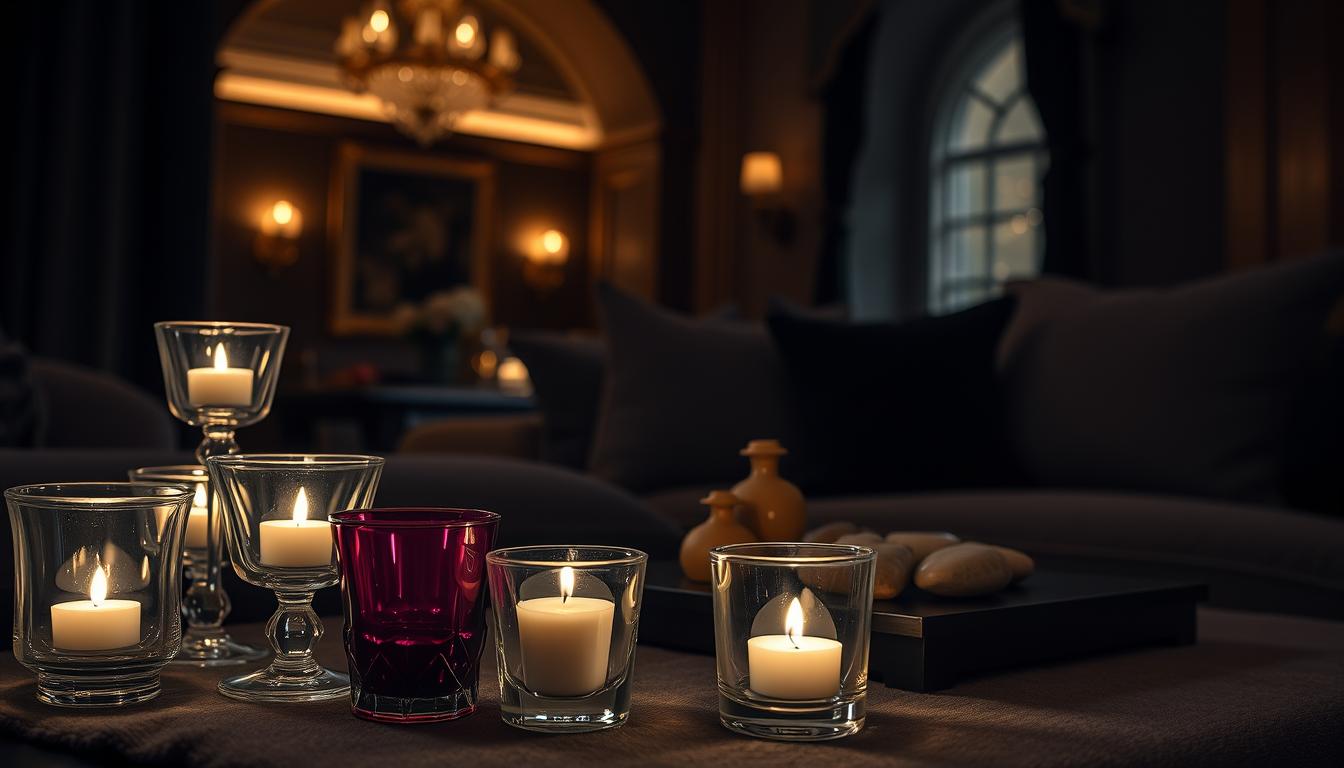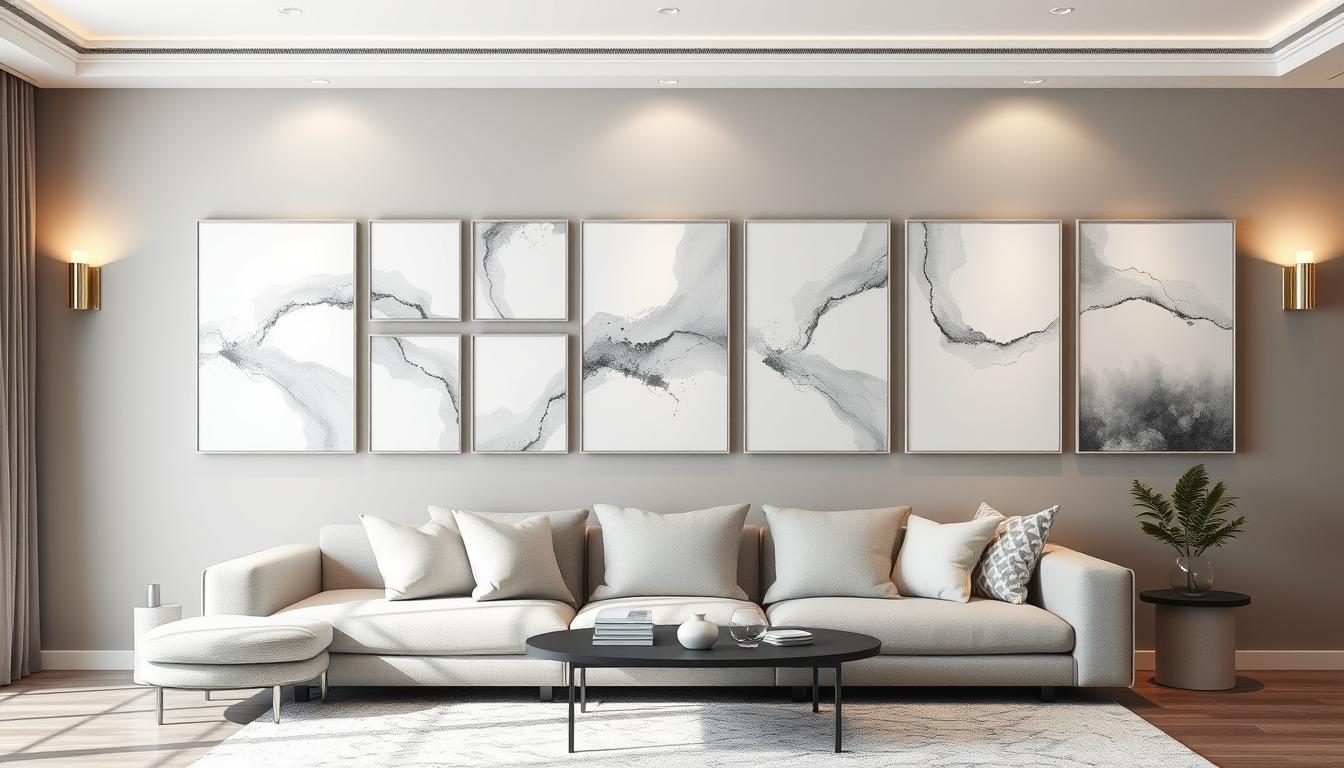Did you know that the atmosphere of a funeral home can greatly affect families during their grief? It’s important to create a space that feels welcoming and comforting. We’ll look at the key parts of funeral home interior design that pay tribute to the deceased and support those who are grieving.
Designing a funeral home is not just about looks; it’s about making a space that offers solace and comfort. Our guide will share expert advice and insights. This will help you strike the right balance, making sure the funeral home decor is both stunning and practical.
Key Takeaways
- Understanding the importance of atmosphere in a funeral setting
- Essential elements for creating a welcoming environment
- Expert tips for balancing aesthetics and functionality
- The role of decor in supporting grieving families
- Best practices for designing comforting spaces
Understanding the Importance of Funeral Home Design
The design of a funeral home is more than looks. It’s about creating a space for families in their darkest moments. A well-designed funeral home offers comfort and support, helping families through their grief.
Funeral home design includes many elements to create a healing environment. It’s not just about the physical space. It’s also about creating a respectful atmosphere for the deceased and comfort for the living.
Creating a Welcoming Atmosphere
A welcoming atmosphere is key in a funeral home. This can be achieved with warm lighting, comfy seating, and calming colors. The goal is to ease families’ pain during hard times.
The entryway sets the tone for the whole funeral home. A well-designed entryway can bring calm and serenity. It prepares families for what’s to come.
Enhancing the Grieving Experience
The grieving process is deeply personal. The design of a funeral home can greatly improve this experience. By offering both comfort and functionality, funeral homes can support families in their grief.
Spaces like viewing rooms, chapels, and family rooms are crucial. Each space should be designed with care, meeting the needs of families and staff.
Balancing Functionality and Aesthetics
It’s important to balance functionality with beauty in funeral home design. The space should be both stunning and practical.
The layout should make it easy for staff and visitors to move around. At the same time, the décor should create a peaceful atmosphere.
| Design Element | Functionality | Aesthetics |
|---|---|---|
| Lighting | Provides necessary illumination | Creates ambiance and mood |
| Furniture | Comfortable seating for visitors | Style and material contribute to overall décor |
| Color Scheme | Influences mood and atmosphere | Creates visual harmony |
Key Elements of Funeral Home Interior Design
Creating a peaceful and respectful space in a funeral home is key. It’s not just about looks; it’s about meeting the emotional needs of grieving families.
Color schemes are a big part of funeral home design. The right colors can make people feel certain ways.
Color Schemes and Their Significance
The color scheme sets the mood of the funeral home. Soft, muted colors like beige, gray, and blue help calm visitors. They reduce stress and anxiety.
- Beige and neutral tones offer warmth and comfort.
- Gray brings balance and serenity.
- Blue tones promote calmness and peace.
Some funeral homes use traditional or cultural colors. This reflects the community they serve.
Furniture Choices for Comfort and Style
Furniture choice is vital in funeral home design. Comfortable seating is key for families and guests who may stay for a while. The furniture’s style should match the funeral home’s look.
When picking furniture, think about:
- Durability: It should handle frequent use well.
- Comfort: Chairs and sofas need to be comfy for long sits.
- Style: It should fit with the funeral home’s design theme.
Funeral home furniture trends are changing. Many now choose modern and versatile designs that meet different needs and tastes.
Lighting Considerations for Ambiance
Lighting is key in setting the mood of a funeral home. Soft, warm lighting welcomes and comforts. Brighter lights are needed for reading or service areas.
Dimmable lighting is great for adjusting the mood. It lets you change the lighting for different family needs and services.
By focusing on color schemes, furniture, and lighting, a funeral home can be both respectful and supportive. It helps those it serves in their time of need.
Layout Planning for Optimal Flow
A well-planned layout is key for funeral homes. It ensures services flow smoothly and comforts grieving families. It also meets the needs of families and staff.
Entryway Design and First Impressions
The entryway is the first thing families and visitors see. It sets the tone for the whole place. A welcoming design includes comfy seating, good lighting, and clear paths.
We suggest adding elements that show the funeral home’s character. This creates warmth and respect right away.
Arrangement of Viewing Rooms
Viewing rooms need careful planning for a respectful space. They should fit different family sizes and ceremony types. Important features are flexible seating, right lighting, and tech for presentations or streaming.
For more on designing these rooms, check our guide on funeral home interior decorating.
Designing Multi-Purpose Spaces
Multi-purpose spaces are vital in funeral homes. They host various events, from memorial services to family meetings. Designing these spaces requires thinking about flexibility, sound quality, and adaptability.
Some essential features are:
- Flexible seating and movable partitions for different sizes.
- Top-notch audio-visual gear for presentations and streaming.
- Adjustable lighting for the right mood for each event.
By focusing on these, funeral homes can make spaces that are both useful and comforting for those they help.
Incorporating Technology in Design
Technology is changing how we honor loved ones in funeral homes. Modern tech makes services more inclusive and personal. It helps families and guests feel more connected.
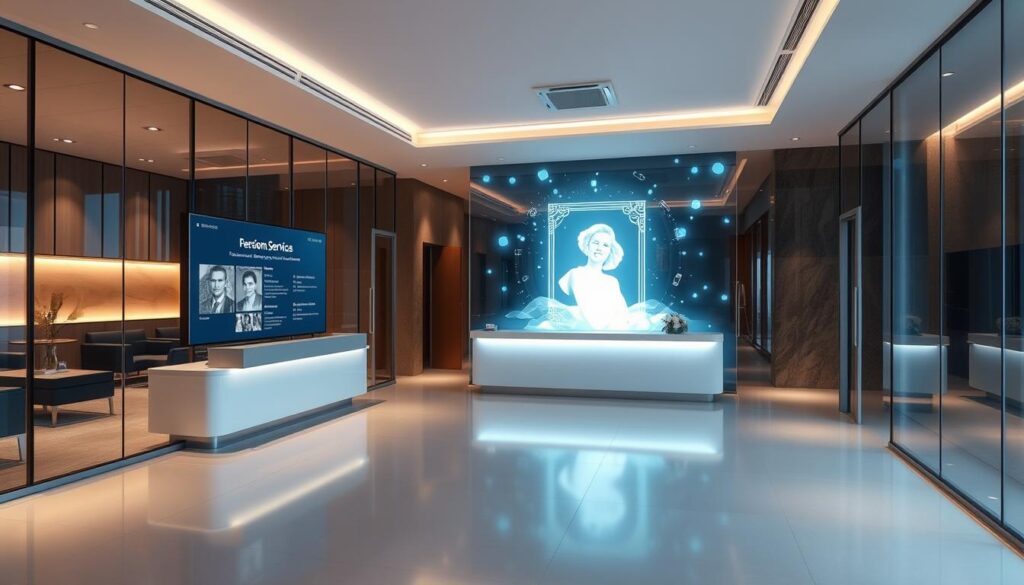
Audio-Visual Equipment for Services
Audio-visual equipment is a big part of funeral home design now. You’ll find top-notch sound systems, big screens, and even virtual reality. These tools let families share personal photos and videos, making the service more meaningful.
Online Streaming for Remote Guests
Online streaming is key for those who can’t be there in person. It lets everyone join the service, making it more open. This tech is a big help for those who can’t attend.
Digital Memorialization Options
Digital memorials are a big deal now. Funeral homes offer online spaces for families to share stories and photos. It’s a lasting way to honor loved ones and a place for everyone to grieve together.
With these tech upgrades, funeral homes are making services better. They’re more personal, easy to get to, and memorable for those who are grieving.
Selecting Appropriate Materials and Finishes
Creating a comforting and dignified environment in a funeral home is key. The right materials and finishes are crucial. They affect the look and feel of the space, impacting visitors’ experiences.
Flooring Options for Durability and Comfort
The flooring must be both durable and comfortable. Hardwood flooring is a top pick for its lasting quality and classic look. But, carpeting is better for quieter areas like viewing rooms. It’s important to choose flooring that looks good and is easy to keep clean.
Wall Treatments That Feel Inviting
Wall treatments greatly influence the funeral home’s feel. Paint offers a wide range of colors for a calming or dignified mood. Wallpaper or wood paneling add texture and warmth. The goal is to make the space feel welcoming and respectful.
Choosing Furnishings That Last
Furnishings must be durable and comfortable. Furniture should stand up to frequent use while being cozy. Stain-resistant fabrics are a smart choice. The style of the furniture should also match the funeral home’s look, improving its funeral home aesthetics.
In summary, picking the right materials and finishes is vital for a funeral home. By choosing wisely for flooring, wall treatments, and furnishings, funeral homes can offer a space that is both comforting and dignified for visitors.
Accessibility Features in Funeral Homes
Accessibility is key in modern funeral home design. We aim to make spaces welcoming for all families and guests. This means following rules and creating easy-to-use environments.
Complying with ADA Regulations
The Americans with Disabilities Act (ADA) guides funeral home accessibility. It’s not just about ramps and wider doors. It’s about making spaces for everyone.
Funeral homes must check their facilities regularly. This helps find and fix any issues. For example, having accessible parking is very important.
| ADA Requirement | Description | Benefit |
|---|---|---|
| Accessible Parking | Designated parking spaces near the entrance | Ease of access for guests with mobility issues |
| Ramps and Entrances | Ramps or level entrances for easy access | Inclusive entry for all guests |
| Wide Doorways and Hallways | Minimum width to accommodate wheelchairs | Unobstructed movement throughout the facility |
Designing for Everyone’s Needs
Accessibility is more than following rules. It’s about making a space that feels welcoming. This includes flexible seating and quiet areas.
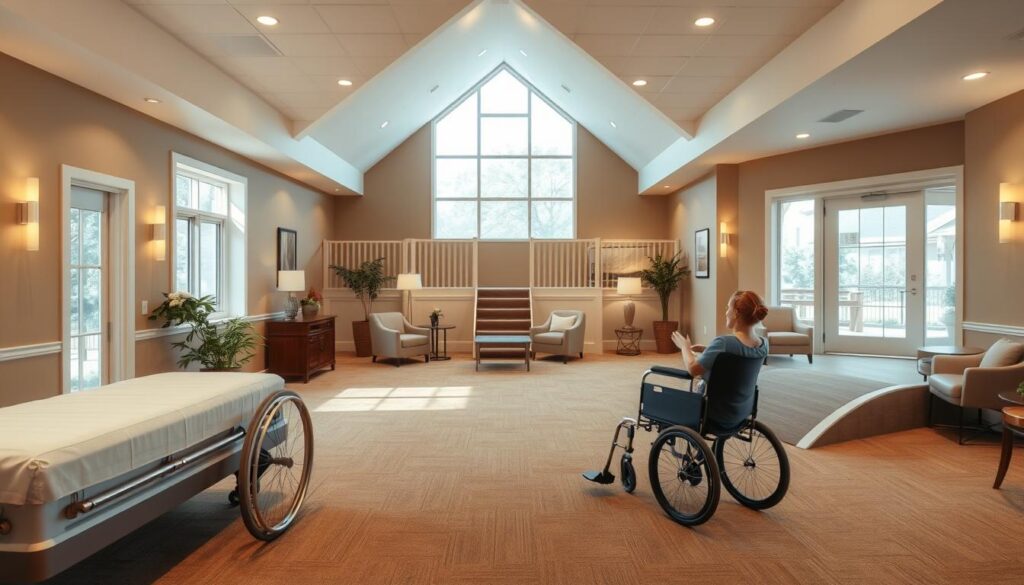
Accessibility in Restroom Facilities
Restrooms are a big part of accessibility in funeral homes. They need grab bars, lowered sinks, and emergency alarms. There must also be enough room to move around.
By paying attention to these details, we make our funeral homes more welcoming. They become places where everyone feels comfortable.
Personalizing Spaces for Individual Needs
Funeral home decor can be deeply personal, making a big difference for families. “Personalization is the key to creating a meaningful and memorable experience,” says a renowned funeral home designer.
Personalization lets families create a space that truly reflects their loved one’s spirit. This can include family rooms, themed decor, and memorial spaces. Each element adds a unique touch.
Family Rooms: Making it Personal
Family rooms in funeral homes offer a private space for families to share stories and find comfort. They are designed to be cozy, with comfortable seating and warm lighting. Adding family photos, heirlooms, or personal mementos makes the space special.
As funeral chapel design evolves, family rooms become more important. These spaces provide a peaceful haven for families during tough times.
Themed Décor for Different Celebrations
Themed decor adds a unique touch to funeral celebrations. It reflects the deceased’s personality, interests, or hobbies. This creates a space that truly honors their memory.
- Themed decor can include custom lighting, personalized banners, or specific color schemes that resonate with the family’s preferences.
- It can also involve incorporating personal items or mementos that hold sentimental value.
When designing these spaces, we must focus on the emotional aspects. We aim to make the funeral home welcoming and supportive.
Memorial Spaces that Resonate
Memorial spaces are a key part of funeral home decor. They provide a place for families to remember and celebrate their loved ones. These spaces are designed to be serene, with elements like candles, flowers, or water features.
“A well-designed memorial space can be a powerful tribute to the deceased, providing a sense of comfort and peace for those who are grieving.”
By adding personal touches and meaningful elements, memorial spaces become lasting tributes. They resonate with families for years to come.
Eco-Friendly Considerations in Funeral Design
Funeral home design is changing to be more eco-friendly. This shift aims to reduce environmental harm while creating a comforting space for families. It’s a big change in the industry.
Sustainable Materials and Practices
Using sustainable materials is a key part of eco-friendly funeral home design. This includes:
- Reclaimed or recycled wood for furniture and flooring
- Low-VOC (Volatile Organic Compound) paints and finishes
- Energy-efficient lighting and HVAC systems
These choices help funeral homes reduce their environmental impact. For example, reclaimed wood is not only eco-friendly but also adds a unique touch to the space.
Incorporating Nature into the Design
Bringing nature indoors is another way to make funeral homes eco-friendly and welcoming. This can be done by:
- Incorporating living plants or green walls
- Using natural elements like stone or wood in décor
- Maximizing natural light through strategic window placement
Nature has a calming effect, offering solace to those grieving. By adding natural elements, funeral homes can create a peaceful environment.
Green Certifications for Funeral Homes
Green certifications show a funeral home’s commitment to sustainability. Certifications like LEED (Leadership in Energy and Environmental Design) highlight buildings that meet environmental standards. The benefits include:
- Enhanced reputation through demonstrated environmental responsibility
- Potential cost savings through energy efficiency
- Compliance with increasingly stringent environmental regulations
By aiming for green certifications, funeral homes contribute to a sustainable future. They also set a new standard in environmental stewardship.
Trends in Funeral Home Interior Design
Funeral home interior design is changing to meet new needs and tastes. We see modern styles becoming more popular as we look at the latest trends.
Modern Aesthetics
Today’s funeral home design focuses on clean lines and simple shapes. It also values functionality. This modern look makes spaces welcoming for families and friends to come together.
Simplifying Spaces
Minimalism is becoming a big trend in funeral home design. It’s all about simplicity and calm. By removing extra details, funeral homes can offer a peaceful place for grieving.
Versatile Spaces
Another big trend is multi-use spaces in funeral homes. These areas can serve different needs, making services more flexible and responsive. This flexibility helps funeral homes meet various requirements.
As trends in funeral home design keep changing, it’s key for funeral homes to listen to their communities. By adopting modern styles, minimalism, and versatile spaces, they can offer a supportive and meaningful place for saying goodbye.

